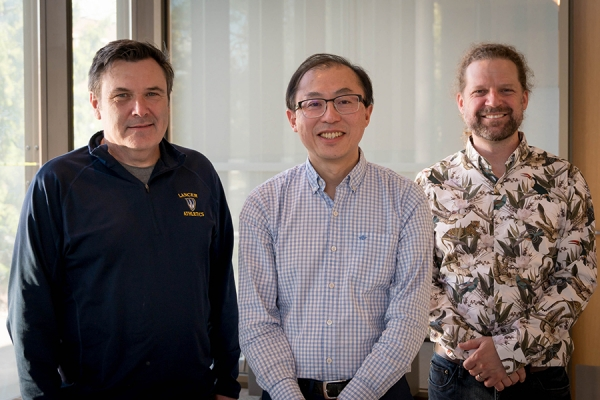
Professors Mike McKay, Kenneth Ng, and Dan Mennill are leading an investigation into avian flu infections in local wild birds.
So far there have been relatively few instances of humans contracting avian influenza, but that is no reason for complacency, says chemistry professor Kenneth Ng.
"The concern is that each time there is a spillover infection from a bird to a human or from a cow to a human, we are rolling the dice and giving the virus another chance to pick up additional mutations that could then allow it to start spreading efficiently among humans," Dr. Ng says. "When that happens, there will be an outbreak that could be the start of a major public health problem."
He is the project lead on a team of scientists exploring the diversity of influenza virus subtypes infecting wild bird populations in Windsor-Essex. Using environmental samples taken from areas of Essex County where both migratory and resident birds congregate, they will monitor the levels and types of influenza infections to help prepare for future spread into commercial livestock and humans.
Avian influenza primarily affects birds, but since March 2024, it has spread widely for the first time in dairy cattle across 15 states in the U.S. Genomic sequencing of influenza virus in cattle, birds, and humans provides an opportunity to identify mutations that help the virus infect and reproduce more efficiently in different hosts. The researchers will develop a platform to rapidly monitor changes in influenza virus subtype composition.
"With the first human case of H5N1 avian influenza in Canada very recently confirmed in B.C., this adds to a few dozen documented human cases in the U.S. over the past year," Ng says.
"Fortunately for now, these cases have all been isolated, and the virus does not spread efficiently in humans. As seen with the recent dairy cow infections, however, the situation can change quickly as the virus continues to evolve."
The one-year $150,000 Canadian Institutes of Health Research Catalyzing One Health Research on Avian Influenza grant is sponsored by the CIHR Centre for Research on Pandemic Preparedness and Health Emergencies.
"This work will establish and validate a novel and sustainable surveillance platform at a border region that acts as a critical gateway for the entry of viruses and other pathogens into Canada," Ng says.
"We aim to develop and test a virus sampling and genome sequence analysis workflow targeting environmental samples from key sites identified within the Windsor-Essex border region, an area with particular significance for migratory birds at the confluence of two of the four major flyways in North America."
Along with Ng, team members Dan Mennill, a professor of integrative biology, and Great Lakes Institute for Environmental Research (GLIER) director Mike McKay each bring their own unique expertise to the project.
Cam Chevalier, a graduate student working with Dr. Mennill, will lead the work to identify productive sampling sites for resident and migratory waterfowl likely to harbour avian influenza viruses.
Ryland Corchis-Scott, a graduate student working with Dr. McKay, will lead the work to process environmental samples and test them for influenza viruses.
Ana Podadera, a post-doctoral fellow in Ng's research group, will lead the work to develop virus genome sequencing methods, and to compare sequences obtained from wild and domesticated animals, as well as people.
By working closely with members of the Canada Biomedical Research Fund supported INSPIRE network, Ng says they will integrate this surveillance platform into a broader public policy decision-making structure to help leaders in government and industry use information about viral infections in wildlife, farm animals, and humans from a One Health perspective. Rowena Hill-Ernesto, training co-ordinator at INSPIRE, will lead efforts to engage with livestock producers and regulatory agencies.









